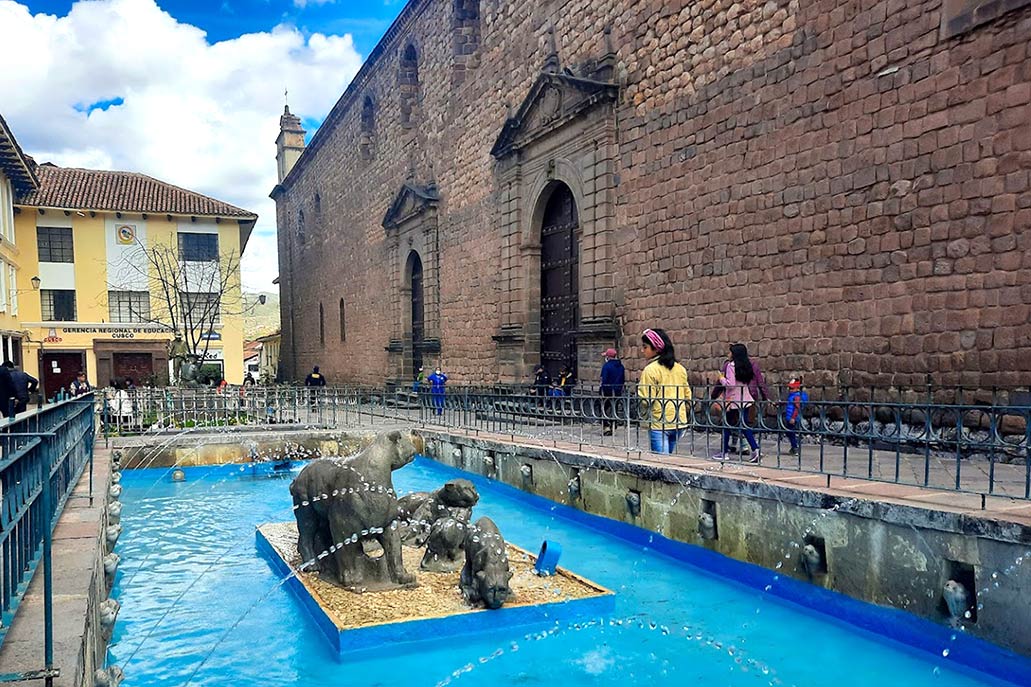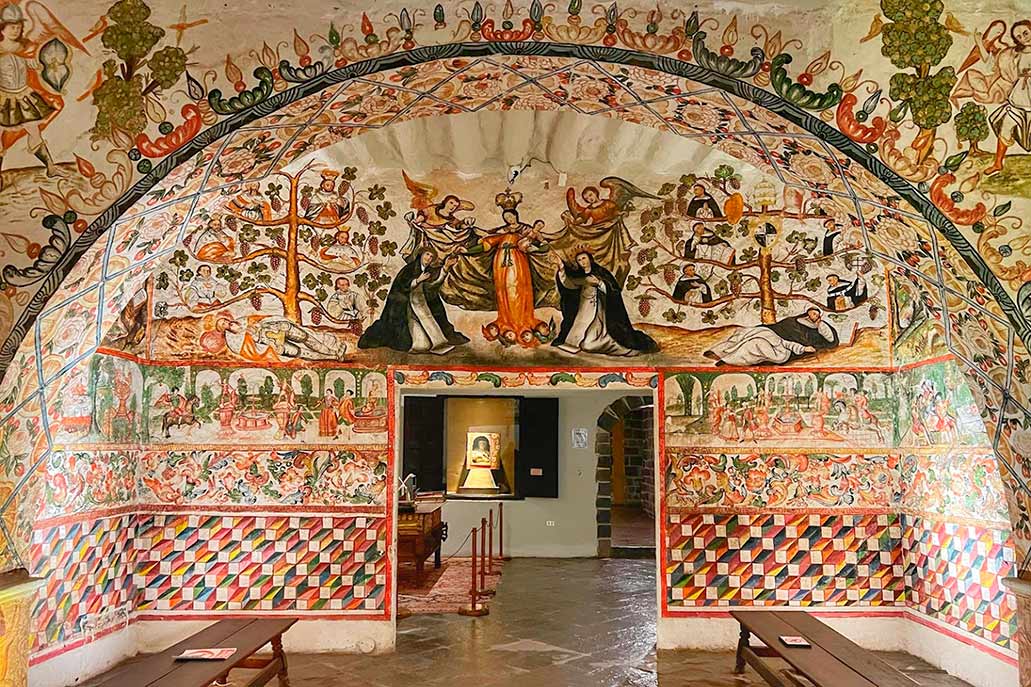Santa Catalina Convent in Cusco museum of monastic life
It is one of the most important religious complexes and of great historical value. This convent and church of Santa Catalina, like most important temples or religious buildings, has a large number of paintings from the Cusco Baroque. However, the most representative thing about this place is that it continues to function uninterruptedly from its foundation to the present day, and it also has a museum of monastic art.
Contenido
1. History of the Santa Catalina Convent of Cusco
Since its foundation, it has been inhabited by the Catholic Religious Community of Contemplative Nuns who belong to the Dominican Order, also called the Order of Preachers. This Catholic Order was the first to arrive in Peru during the 16th century. So you can show different temples or buildings with their representative shield. One of them is the Santo Domingo temple, which was built on the remains of the Coricancha.
The Monastery of Santa Catalina is one of the three oldest communities of cloistered nuns founded in Cusco in the colonial period. Functioning uninterruptedly from the moment of its creation, despite the fact that during the Republican era they suffered some economic declines.
Before settling in Cusco, this congregation was founded in the city of Arequipa. The impulse of the creation is due to Doña Lucia Padilla and her daughter Doña Isabel. Doña Isabel entered the monastery of Arequipa, becoming a prioress. By dedicating herself to this religious life after becoming a widow, she always had the support of her mother. For this reason, when the male descendants of this family died, her mother decided to donate all her assets to the congregation to which her daughter belonged.
Originally the convent was called “Our Lady of Remedies” in reference to the old antique dedication in Andalusia. This is because the Padilla family descended from these territories.
After the different events of natural disasters, such as the eruption of the Huaynaputina volcano and the earthquake in 1604, the padillas, as leaders of the congregation, made the decision to move the monastery from Arequipa to Cusco by approval of Bishop Monsignor Antonio de la Raya. It was a transcendental fact because of the unusual nature of this decision. 25 professed nuns and two girls traveled on the first day of the year 1605. It is said that in order not to be seen by profane eyes, they covered their faces with veils when meeting strangers. Upon arriving in Cusco, they were granted an important piece of land for the Tawantinsuyo, the Acllahuasi site.
2. The Acllahuasi in the Tawantinsuyo
When they arrived in Cusco they were received in what would be their new ranch. The Acllahuasi, or enclosure of the “Chosen Women”, was given to them so that they could build and carry out their work. Before the Spanish conquest, women chosen for their beauty or high lineage lived in this enclosure. These women remained without contact with the outside world until they reached adulthood. They were forbidden any kind of communication with men, they were only cared for by elders, eunuchs and the mamacunas. Some of them left this enclosure to become wives or concubines of the Inca or high dignitaries of the Tawantinsuyo. Others became servants of temples and sanctuaries and were considered wives of the sun god. Their main occupations were making fine textiles for the Inca court and preparing ceremonial beverages, activities considered sacred.
The house of the chosen women of Cusco was the richest and largest of all and housed the most beautiful maidens, mostly from the Cusco elite. The first Europeans who saw this custom did not take long to find a simile with the Catholic monastic communities calling the acllas, nuns. In this way, the takeover of the old Acllahuasi by the Dominican nuns was seen as a symbolic act that traced continuity with the Inca traditions and with the new cultural order.
Inside the Acllahuasi, there were passageways and streets around which were the workshops and homes of the women. As for the Inca construction that remains until today, we have the longest fragment of a wall that can be seen walking down Loreto street. Other remains can be seen on the corner of Calle Arequipa that faces the Plaza de Armas.
3. Some important information about the Santa Catalina Convent in Cusco
After its transfer to Cusco, the monastery began to be called Santa Catalina de Sena, in honor of the saint of the same name. In 1650 the famous earthquake in Cusco left the barely built monastery in ruins, leaving one of the sisters buried. While the reconstruction lasted, the nuns had to seek temporary refuge in the houses of the neighbors. In 1651 the reconstruction of the temple began. This reconstruction did not undergo major changes until today.
The ancient Inca nobility, Christianized and transformed, whose first generation still held great importance within Cusco, found their place in monastic life. During the year 1619, Doña Leonor de Esquivel, daughter of Melchor Carlos, the last Inca proclaimed and recognized as such by the Spanish crown, professed vows within the monastery. Doña Leonor died as a nun inside the cloisters. A few years later, she entered the monastery of Doña Feliciana Pinelo, great-granddaughter of the Inca Tupac Amaru I, the last leader of the Inca resistance against the Spanish invasion.
For a young woman to enter the monastery her family had to pay a dowry, according to the dowry she was granted a rank within the monastery facilities:
- The most senior were the black-veiled professed nuns. To access this rank, the family had to pay a fixed contribution of 3,312 pesos with 4 reais. Something really elevated for that time.
- The next rank was occupied by the white-veiled professed nuns whose value consisted in paying the dowry of half the dowry of the black-veiled ones. The ladies of more modest status had the option of entering as donates by contributing a dowry of 500 pesos. That demanded, in any case, a great effort from the families. They were dedicated to domestic chores within the community and did not make decisions at any time.
The nuns of high economic conditions and accustomed to that lifestyle, kept living that way within the monastery facilities. They obtained permission to have autonomous cells in various rooms attended by maids and slaves who could leave the premises without any problems. Sometimes they were allowed to house relatives or relatives, but only women.
Some nuns raised little women, given by their family for their education away from worldly temptations. Some could be servants or apprentices depending on their economic condition of origin. Many times the cloisters of the monastery served as a refuge for battered women or widows or a correctional place for rebellious women.
4. Attractions of the Monastery of Santa Catalina in Cusco
- On the façade of the Santa Catalina Monastery in Cusco you can find a stone-based construction. It has two doors surrounded by carvings and Renaissance forms, the same is the case with a tarnished one as a bell tower.
- Most of the building style is late renaissance. It has an important characteristic that is its Roman-style arches. Over time, some of the other doors and windows were sealed to prevent the nuns from having contact with the outside of the cloister. It is a monumental but simple building with a single nave.
- It has a room in which the different works of painting and sculpture that were acquired from the famous Cusco school are exhibited over time. Likewise, the Museum of Monastic Life is dedicated to displaying gold and silver work, textiles, sculptures, and altarpieces.
- It has canvases by anonymous authors that represent important images such as the painting of El señor de los Temblores, and a collection that details the life and miracles associated with Santa Rosa de Lima.
- It has different liturgical objects that are exhibited, you can find murals, carved gold and silver jewelry. The presence of a chapel with representation of flora typical of the Inca worldview.
- The trunk that holds the model of the life of Christ is exhibited, an instrument that was used for evangelization. There is a wide exhibition of what life-size monastic life is like within the convent facilities.
5. Price for the entrance to the Monastery
The price to access the museum is 8 soles or 2.5 US dollars, approximately. Students who support their accreditation pay only 4 soles.
6. Opening hours of the Monastery
It is possible to visit the Santa Catalina Monastery every day of the week from 8:30 a.m. to 5:30 p.m.
The exact address is Calle Arequipa 401, Cusco.
By Imachupicchu – Last updated, August 22, 2024

